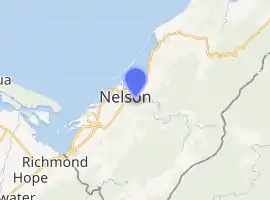Maitai, New Zealand
Maitai is an inner suburb of Nelson, New Zealand. It lies at the western edge of Nelson city centre, immediately to the south of The Wood, on the northern bank of the Maitai River. A monument representing the location of the geographic centre of New Zealand is located in Maitai.[2]
Maitai
Maitai (Māori) | |
|---|---|
Suburb | |

| |
| Coordinates: 41°13′40″S 173°19′20″E | |
| Country | |
| Region | Nelson |
| Territorial authority | Nelson |
| Government | |
| • Nelson City Mayor | Rachel Reese |
| • Nelson MP | Rachel Boyack |
| • Te Tai Tonga MP | Rino Tirikatene |
| Area | |
| • Total | 1.01 km2 (0.39 sq mi) |
| • Land | 1.01 km2 (0.39 sq mi) |
| • Water | 0 km2 (0 sq mi) |
| Population (June 2020) | |
| • Total | 1,410[1] |
| Time zone | UTC+12 (NZST) |
| • Summer (DST) | UTC+13 (NZDT) |
| Postcode | 7010 |
| Area code(s) | 03 |
The population was 609 in the 2013 census. This was an increase of 9 people since the 2006 Census.[3]
Geography
Maitai covers an area of 0.93 km², all of which is land.[4]
Maitai has several public reserves, many located within Nelson's town belt, including the Botanical Gardens cricket ground, Branford Park, Maitai Cricket Ground, Maitai Arboretum, Maitai River Esplanade, Sharland Hill Reserve and Sir Stanley Whitehead Park.[5]
Maitai Valley Road, a steep, winding road linking Nelson with Maitai Reservoir and Pelorus Bridge, follows the northern bank of the Maitai River.
Hanby Park, located on the southern side of the river, includes walking and BMX trails.[6] There is also a residential area near the park.[7][8]
A popular swimming hole, Black Hole, is located at a bend of the Maitai River.[9]
History
The estimated population of Maitai was 1,480 in 1996.[10]
It was recorded as 1,410 in 2001, 1,370 in 2006, 2,630 in 2013, and 2,660 in 2018.[10]
Demography
Maitai has an estimated population of 1,410, with a population density of 1,512.62 people per km².[11]
As of the 2018 census, the median age was 43.3, the median income was $32,400, 6.6% of people earned over $100,00, 39.0% had a Bachelor's Degree or higher, and 2.9% of the workforce was unemployed.[10]
Ethnically, the population was 90.1% New Zealand European, 7.3% Māori, 1.1% Pacific peoples, 7.3% Asian, 0.9% Middle Eastern, Latin American, or African, and 1.1% identified with other ethnicities; 33.7% were born overseas.[10]
Religiously, the population is 64.3% non-religious, 24.9% Christian, 0.0% Hindu, 0.2% Muslim, and 0.4% Buddhist.[10]
Economy
In 2018, 6.0% of the workforce worked in manufacturing, 7.3% worked in construction, 10.5% worked in hospitality, 2.8% worked in transport, 12.1% worked in education, and 14.1% worked in healthcare.[10]
Transport
In 2018, among those who commuted to work, 52.8% drove a car, 2.0% rode in a car, 14.1% use a bike, and 14.1% walk or run.[10]
References
- "Population estimate tables - NZ.Stat". Statistics New Zealand. Retrieved 22 October 2019.
- Wise's Nelson-Blenheim "Easyread" Map ISBN 1 877402 50 8
- 2013 Census QuickStats about a place : Maitai
- "Statistical Area 2 2018 (generalised) GIS" (Data table). stats.govt.nz. Statistics New Zealand.
- "Nelson Parks and Reserves". gdc.govt.nz. Gisborne District Council.
- O'Connell, Tim (10 December 2016). "Bikers hopping mad over potential Hanby Park bulldozing". stuff.co.nz.
- "Solar Power Nelson". bdnsolar. Retrieved 2 February 2019.
- "Nelson Southern Link Investigation" (PDF). Retrieved 2 February 2019.
- Kidson, Sally (18 February 2009). "Carefree summers on the Maitai". stuff.co.nz. Nelson Mail.
- "Place Summary – Maitai". Stats NZ. Statistics New Zealand.
- "Provisional Statistics". stats.govt.nz. Statistics New Zealand.
